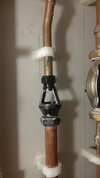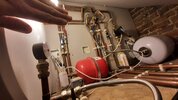I think he means the primary circuit is unvented. The HW cylinder may not be mains pressure type. Perhaps the OP will confirm.The water in the coil in your cylinder is the same water that circulates through the rads and ufh so draining that leaky pipe will involve draining rads- as you say, only the upper floor though.
If the leak is in the pipe run from boiler to cylinder then crack on. If (as is quite likely) the leak is tracking from a fitting on the cylinder you're venturing into G3 registered territory (cos the thing is pressurised).
You are using an out of date browser. It may not display this or other websites correctly.
You should upgrade or use an alternative browser.
You should upgrade or use an alternative browser.
Leak in indirect HW circuit - do I need to drain and solder?
- Thread starter pedr0
- Start date
Do you mean sealed, in other words pressurised? Unvented is a type of hot water system/cylinder and needs a qualification to work on.My system is an unvented system.
Ahh, good point- think @Madrab has already asked the QI think he means the primary circuit is unvented. The HW cylinder may not be mains pressure type. Perhaps the OP will confirm.
HW cylinder is mains pressure type. I.e. I don't have a cold water tank but I do have a pressure vessel.
After terryplumb helped me understand that UFH CH and HW are all fed by same flow and return, I'm starting to think that the leak travels in the ceiling void before coming through the ceiling. The location of the water on the ceiling was making me think that it was in the run between the cylinder and the boiler. But because it only drips when the cylinder is being heated, the leak must be after the boiler flow and return are split/directed to CH/UFH/HW. And all that happens near the cylinder, not near the boiler.
Going to find the source of the leak today and report back. And because the leak is probably near the cylinder, I might even be able to find it without cutting ceilings!
After terryplumb helped me understand that UFH CH and HW are all fed by same flow and return, I'm starting to think that the leak travels in the ceiling void before coming through the ceiling. The location of the water on the ceiling was making me think that it was in the run between the cylinder and the boiler. But because it only drips when the cylinder is being heated, the leak must be after the boiler flow and return are split/directed to CH/UFH/HW. And all that happens near the cylinder, not near the boiler.
Going to find the source of the leak today and report back. And because the leak is probably near the cylinder, I might even be able to find it without cutting ceilings!
OK. But as the leak is on the HW cylinder primary circuit I can't see why it would need G3. But maybe somebody will disagree.HW cylinder is mains pressure type. I.e. I don't have a cold water tank but I do have a pressure vessel.
- Joined
- 8 May 2017
- Messages
- 10,479
- Reaction score
- 2,775
- Country

I don't disagree ,and we don't yet know exactly what the leak originates from anyway.OK. But as the leak is on the HW cylinder primary circuit I can't see why it would need G3. But maybe somebody will disagree.
Point taken, but if the leak is on the cylinder or one of the pipe connections to it, I'd have thought he could spot it.I don't disagree ,and we don't yet know exactly what the leak originates from anyway.
- Joined
- 8 May 2017
- Messages
- 10,479
- Reaction score
- 2,775
- Country

Sounds like it's somewhat remote from the cylinder,we will wait and see.
After terryplumb helped me understand that UFH CH and HW are all fed by same flow and return, I'm starting to think that the leak travels in the ceiling void before coming through the ceiling.
Is the floor not easier to lift than damaging the ceiling.
Still haven't found the leak. However, shortly after turning the hw on, a small trickle flows into a recepticle which passes it into a copper pipe which is connected to the soil stack.

Is this to relieve pressure as the water in the cylinder expands? Is it normal /expected?
Here's a wider angle

For context, the cylinder is a horizontal gledhill tank just to the left of the pic, just in view below my hand

Is this to relieve pressure as the water in the cylinder expands? Is it normal /expected?
Here's a wider angle

For context, the cylinder is a horizontal gledhill tank just to the left of the pic, just in view below my hand
- Joined
- 8 May 2017
- Messages
- 10,479
- Reaction score
- 2,775
- Country

That's a tundish ,and shouldn't have water flowing through it unless there is a problem,with hot water expansion not being accommodated ,or the PRV is passing when it shouldn't. Probably the former. Have you followed the pipe from the lower part of the tundish connection ,to see if it's leaking ?
That receptacle is called a tundish. It's there so you can see when water is flowing through it, which it shouldn't do under normal circumstances. Not sure those pressure relief vessels will work properly on their sides.
- Joined
- 8 May 2017
- Messages
- 10,479
- Reaction score
- 2,775
- Country

You could ,but I doubt it would make much difference.
Where does the pipe run , in relation to water on the ceiling?
As you know where water is showing on the ceiling ,is it not possible to expose that area from above ,where water should be visible on top of the ceiling ?
Where does the pipe run , in relation to water on the ceiling?
As you know where water is showing on the ceiling ,is it not possible to expose that area from above ,where water should be visible on top of the ceiling ?
DIYnot Local
Staff member
If you need to find a tradesperson to get your job done, please try our local search below, or if you are doing it yourself you can find suppliers local to you.
Select the supplier or trade you require, enter your location to begin your search.
Please select a service and enter a location to continue...
Are you a trade or supplier? You can create your listing free at DIYnot Local
Similar threads
- Replies
- 7
- Views
- 711
- Replies
- 14
- Views
- 3K
N
- Replies
- 1
- Views
- 470
